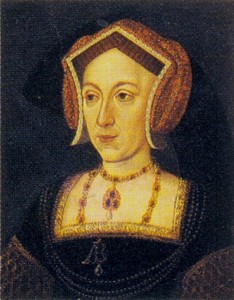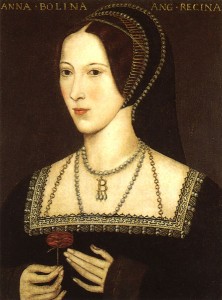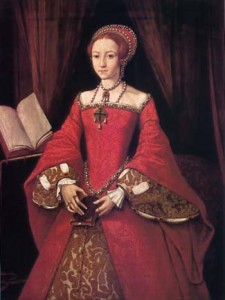Accompanying this first letter was Henry’s picture set in a bracelet with ‘the device which you already know’ (Starkey, Pg. 280).
In the year proceeding May 1532, Henry VIII lavished much jewellery on Anne Boleyn. Not only was he preparing her for the European stage, he was also preparing her for the position of Queen of England.
‘In the year to May 1532 Cornelius Hayes’ bill included three dozen items of jewellery for ‘Mistress Anne’, costing almost £100. The largest item is a girdle of crown gold billed at £18 10s.4d., but the most intriguing is a Catherine wheel of gold set with thirteen diamonds at just under £4’ (Ives Pg. 251).
In 1532 Henry reset much of the royal jewellery for Anne, setting aside the best stones for her. He also stripped Catherine of Aragon of her jewels, this obviously did not please the former queen and she responded by saying that it would be a sin for her jewels to adorn ‘the scandal of Christendom’ (Ives, pg. 158).
Although there is no surviving portrait of Anne by Holbein we know that he designed for Anne a pendant with ‘a central stone and the initials ‘H’ and ‘A’ intertwined’ (Ives. Pg 251). He also designed a shield with the same cipher.
After Anne’s death in 1536, a wooden desk containing pieces of Anne’s jewellery was inventoried. The items included a diamond ring with the ‘HA’ cipher, another diamond ring with the cipher and the text (in Latin), ‘O Lord make haste to help me,’ and a third ring had a broken part of her motto, ‘Moste…’ (Ives Pg. 251).
Among other items of Anne’s jewellery inventoried was a brooch with ‘RA’- standing for ‘Regina Anna’ – in diamonds and other items with ‘HA’.
One pictorial tradition has Anne wearing three strands of pearls across the bodice, a necklace of rubies and pearls, a choker and matching pendant and a brooch made up of the letters ‘AB’ in gold with a drop pearl.
Another tradition depicts Anne with a pearl choker from which a gold letter ‘B’ hangs with three drop pearls.
Ives believes that the pearls are so similar to those worn in the earliest portraits of Elizabeth ‘as to suggest that the daughter may have been allowed some of her mother’s finery’ (Pg. 252).
I certainly hope that Elizabeth managed to hold onto some memento of Anne.
There are though other theories as to what actually happened to Anne’s famous necklace with the gold B. Some people believe that it went back to the Crown after her downfall and was broken down and reset for Jane Seymour. Others even believe that some of the pearls are in the crown of Elizabeth II!
Unfortunately, of Anne’s personal jewellery, none has survived to be identified.
It was customary to make and remake pieces for the next Tudor sovereign and in Anne’s case; items specific to her would have been almost immediately broken up. Even so, Henry repurchased from Thomas Trappers a gold bowl ‘having Queen Anne’s sapphire upon the top of the cover’ and his post-mortem inventories included a dust bowl of gold (for blotting ink) with a crown on the lid and ‘H’ and ‘A’ in enamel’ (Ives, Pg. 252). Ives goes on to describe how Henry also kept a tablet of gold bearing the monogram ‘HA’ set with small emeralds, pearls and one diamond (Ives, Pg 252).
In the words of Eric Ives, ‘it suggests vividly what has been lost’ and for me raises the question of why did Henry repurchase some of Anne’s items?
Did he want to remember her and the passion and love they once shared? Did he have some fond memories of their time together and want some physical connection to her? Did he feel some guilt over the manner of her death? Did Anne still have a place in his heart after all that had happened? Or was it that he simply liked those pieces?
What are your thoughts?
References
Ives, E. The Life and Death of Anne Boleyn, 2004.
Starkey, D. Six Wives: The Queens of Henry VIII,


















I have no idea why Henry would buy back some of her items since many have made it clear that he had a great dislike for her. Was that dislike a fake? I don’t think anyone will know for sure about Henry’s true feelings just like with Anne;s birth date.
Did you know there are items that are suppose to have been Annes?
One is a clock, Henry’s first love token to Anne was a “tiny gold dog whistle with a salt spoon, earpick and toothpick”
http://www.flickr.com/photos/anne_boleyn/293080621/
another was a vase or large cup I am not sure which it would be called.
Thanks Cindy! Yes, The Boleyn Cup, 1535-6. This 16th century gilded silver goblet was given to Dr Richard Masters by Anne Boleyn, and Dr Masters presented it to the church. St. John the Baptist Church, Cirencester. The clock is partly sixteenth century. The weights are engraved ‘H’ and ‘A’, with lovers’ knots and the mottoes ‘Dieu et Mond Droit’ and ‘The Most Happy’
I would like to think that Henry VIII still had feelings for Anne. I want him to always have some love for her. They were so passionate and I believe it was true love. Henry’s pride was hurt and back then if a woman did not produce a son like she promised, she would not be viewed well. It was so important as a King. Anne was so headstrong, passionate, and spoke her mind. This trait was also not typical of women of the period. So, I believe Henry bought some of her jewelery because he still loved her. As well, he may have wanted his daughter to have something to remember her mother by.
I think Henry carried some guilt and regret with him even though he would be loathe to admit it. I was given a private tour of St. James Palace (built by Henry between 1532-1540)two years ago and in the old throne/receiving room is a firepace with Henry and Anne’s initials entwined in stone on one of the corner pieces. He surely could have had that removed if he had been so inclined.
a private tour? wow so lucky, i would love to of experienced that…i believe that his desperation for a son overshadowed any feeling he had for anyone, although i’d like to think that he still had feelings for Anne i’m finding it hard to understand why he grew ‘tierd’ of her so quickly, she was bound to have a healthy live son eventually. In my own opinion Anne was just a way to get a son initially, and because he had been married to his brothers wife he thought that this was the only way, and because he lusted after her that became an obsession…it is questionable though, but i reckon the keeping the momento’s was for Elizabeths sake, not his. I feel compelled to believe he didn’t really ‘love’ any of the wives, even Jane, if she had had a girl then died would he of been buried besides her? probably not…his feelings were ambitions not love, although its a shame as Anne was my favourite Queen so i’d like to think he felt guilty and did actually love her…but i doubt it.
Anyway if anyone has any recomendations on tours, books of this time, particularly involving Anne Boleyn then please do tell…?
…thanks
I think that as much as we want to romanticize the story and believe that Henry still had feelings (or even loved) Anne, history shows that royals are very attached to what is theirs and go to great lengths to keep things “in the family.” For instance, look at the Romanov jewels. Although much of it was confiscated by the Soviets, many more pieces were purchased (at a ridiculously low price) by the royals in other countries. And who purchased the most? Queen Mary. Probably because 1) they were of great value, 2) they were an excellent price and 3) Tsarina Alexandra is a granddaughter (and rumored favorite) of Queen Victoria. Queen Elizabeth II owns more pieces of the Romanov jewel collection and still wears those pieces.
We should also keep in mind that although Henry gave Anne the jewels, doesn’t necessarily mean that they’re hers to keep. Yes, she “owns” it, but only for the time being because they ultimately belong to Henry, the position (they’re the Queens jewels, it belongs to the position, not the person. That’s why he took it from Katharine of Aragon and gave it to Anne), and/or the state.. Take for instance, the jewelry that belong to Princess Diana. The “important” pieces were returned to the Crown and we have pictures of Camilla Parker Bowles wearing them.
But, if all else fails and my arguments don’t hold, then think about this: maybe it is just more practical to keep the pieces and re-set/re-design them for future use than it is to buy new pieces. So, in essence, they’re probably the first to reduce, reuse, and recycle!
Thank you for your interesting and informative comment. The Queen’s jewels that Henry took from Katherine of Aragon were the official jewels but Anne of course had a lot of personal jewellery separate to those pieces. Many of these ‘personal’ pieces were gifts from Henry. The Tudor monarchs most definitely reset or reused pieces of jewellery, this is undisputed. Although the items in question that Henry repurchased have jewels incorporated, they are not pieces of jewellery. I also take ‘post-mortem inventories’ to mean that they were done after Henry’s death, meaning that Henry kept these items bearing the monogram ‘HA’ for 11 years. So I am not convinced that there wasn’t something more sentimental behind the purchase. It would be fabulous to find out in what year he purchased them back.
I don’t know why he purchased them but I suppose part of the reason might have been some tenderness left for her. I also think he liked to acquire things: tapestries, castles, gold plate, women….so it may have given him a sense of his own power to possess what Anne had once worn.
Henry VIII sustained a head injury during a joust while married to Anne, this has been well documented. In all likelyhood his subsequent behavior is attributable to damage to his pre-frontal cortex, an injury which renders the victim emotionless, in sort of a non-surgical lobotomy state. If this idea is applied to his in the remainder of his life his behavior makes sense.
Even today, many people keep personal belongings of their deceased parents and other relatives, not just because they may be valuable, but as mementos of that person, a link to them. I myself own a number of jewelry, clothing, china and other items from my and my husband’s mothers, grandmothers, his father, and a couple of aunts. We even have his grandmother’s piano, which I seldom have time to play, but we don’t want to sell. So it doesn’t surprise me that Elizabeth may have inherited some of her mother’s belongings, like some of her jewelry and the virginal with Anne’s falcon crest on it. Maybe Henry kept them for her, to pass them along when she was old enough. I believe he loved his children enough to do this, no matter what his own feelings about Anne were, but he secretly might have later regretted her death, and kept some as mementos for himself initially.
I think Ives is wrong regarding the jewellery in Elizabeth’s portrait as a teenager. If you look at the picture closely the pearl strings have gold beads in between the pearls – not present in Ann’s portraits. There is of course the ring made for Elizabeth in the 1570s. I suspect the psychological link with Ann is overplayed. If Elizabeth saw her mother more than 20 times I would be surprised. She certainly made no attempt to retrieve her mother’s body from St Peter’s ad Vincula and provide a better memorial. There is some evidence (tentative) to show that Catherine Howard received some of Jane Seymour’s jewels and certainly Elizabeth is shown in portraits wearing her father’s pendant.
Even Chapuys wrote how devoted a mother Anne was to Elizabeth. Records I reviewed would suggest Anne had Elizabeth with her as frequently as possible. That Elizabeth wore a portrait of her mother in her daily life suggests a bond that would have been forged in real time and actual relationship, not symbolic, particularly since it was a secret ring/portrait. We do not know if Elizabeth attempted to retrieve her mother’s body or chose to have her mother remain a martyr. She had to be careful and may have decided moving her mother’s body was not a battle to pick.I think Elizabeth provided an incredible memorial to Anne in becoming the Queen Anne knew she was destined to be. Between a mother and daughter, that is enough.
He may have bought back what was his to use for Elizabeth’s future dowry. He must have had some thoughts of that. Regarding his obsession with Anne, if perhaps her sister, Mary’s two healthy children were the King’s children, who he could not claim. Then it makes sense to me that he may have thought that the ability to produce healthy children (with him) should run in the family. Today we know that healthwise everyone is an individual even siblings.
My thoughts are that he kept them because he glorifies the mere fact that he got away with murdering her! After all its a known fact serial killers had this sick behavior!